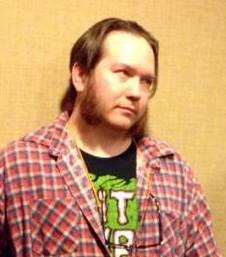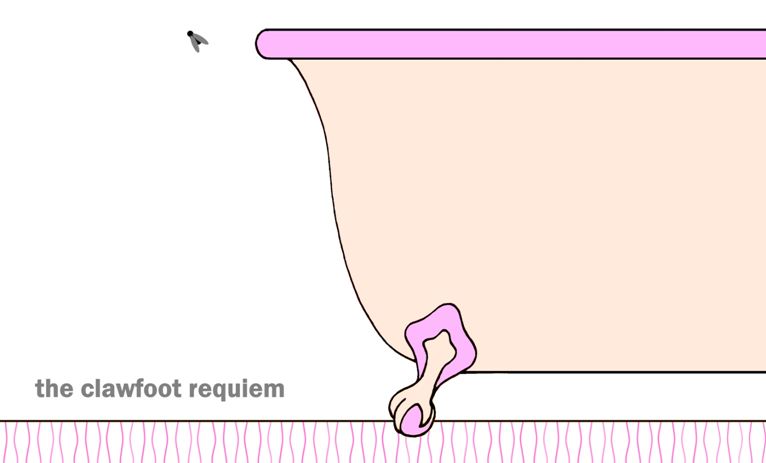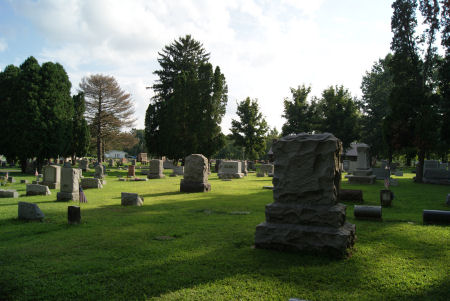Welcome back! Today I’m thrilled to feature author and editor Catherine Grant. Catherine’s fiction has been published in numerous magazines and anthologies, and she’s served as an editor at both LampLight and Shock Totem. She was also recently named Assistant Director of NecronomiCon Providence (congrats again, Catherine!).
Recently, she and I discussed her work as an editor, her inspiration as a writer, as well as the release of her new chapbook, Power in the Blood.
A couple icebreakers to start: when did you first decide to become a writer, and who are some of your favorite authors?
 I’ve wanted to be an author since I was a little kid. I wrote stories all the time in grade school and then when I was fifteen I took a crack at writing something longer. There is a single copy of that story that lives with my best friend and I’m hoping it will never see the light of day. In fact, next time I see her I might steal it and burn it.
I’ve wanted to be an author since I was a little kid. I wrote stories all the time in grade school and then when I was fifteen I took a crack at writing something longer. There is a single copy of that story that lives with my best friend and I’m hoping it will never see the light of day. In fact, next time I see her I might steal it and burn it.
When I was a kid, I was in love with Roald Dahl. I read Matilda over and over because it appealed to me as an intelligent, sensitive little girl living in a world where adults were terrible and sometimes abusive. Matilda’s frustration, loneliness, and, eventual revenge, was so satisfying to me, that I’d imagine Roald Dahl himself must have dealt with abusive relationships with adults as a kid and knew that pain all too well.
My favorite author now is Jeffrey Ford. His writing is beautifully written, vivid, engrossing, original and he has the ability to craft a satisfying ending better than any author alive right now. I will fight anyone who tries to argue this. I wish to someday be half the writer Ford is. His work doesn’t conform to one genre, it is just good story craft, and I think that is also something I’ve recognized as a goal in my own work.
What initially drew you to horror and dark fantasy? Do you remember the first horror film you saw or the first horror story you read? As a writer, what are your favorite mainstays of the genre, and which tropes do you wish would just go away?
I think I’ve always been drawn to darker subject matter, because it seems more genuine to me and evokes more sincere emotion. I started with Scary Stories to Tell in the Dark and then somehow skipped straight to reading Edgar Allan Poe, Stephen King and Anne Rice. Most of that reading was facilitated by the fact that I had a Little Professor Bookstore within walking distance to the house my parents were renting, and plenty of babysitting money to get whatever I wanted, unchaperoned. This is how I ended up with a copy of Nighmares and Dreamscapes by Stephen King at age twelve. That book basically changed my life and made me a lifelong horror fan.
I love any horror story that is really about a family in peril, such as The Shining or The Babadook. One of Stephen King’s strengths is that his horror really isn’t about the monster, it is about the relationships between people and how delicate and complex they are, how easily destroyed or lost to “evil.” I think any “trope” can work as long as it isn’t really about the monster, but about more complex inner and outer conflict that really anchors the story. So, in short, I don’t think any tropes should go away, I think they just need to work harder at capturing audience attention, especially right now when so much media is being done so well.
You are an editor at LampLight, and you have worked as a slush pile reader at other publications in the past. What in particular do you look for in stories? Also, what has editing and reading slush taught you about writing that has helped you as an author?
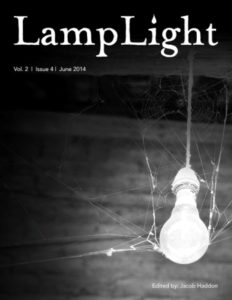 Editing and reading slush has taught me so much about my own writing. I recognize more easily what doesn’t work and what will capture an editor’s attention. Editing has taught me a lot about the structure and pacing of short story writing that I don’t think I could have learned by just writing.
Editing and reading slush has taught me so much about my own writing. I recognize more easily what doesn’t work and what will capture an editor’s attention. Editing has taught me a lot about the structure and pacing of short story writing that I don’t think I could have learned by just writing.
As far as what I’m looking for, I seek out stories with a good hook that get me engrossed in the story right away. I love fiction with a powerful, consistent voice. I want the voice to feel like melted butter on a biscuit as I’m reading it, or like gravel underneath my tongue, whatever works best for the tone and subject matter of the piece. It also needs to be emotionally compelling. Pull on my heartstrings. Make me cry or laugh or want to kick someone’s ass.
I’ve read for both Shock Totem and Lamplight Magazine, and both publications were very different in what the senior editors were looking for. I look for pieces that fit with the tone and vision of the magazine, which has been difficult because there have been pieces that I have loved as a reader, but as an editor, they just didn’t fit. This is why I tell writers that “isn’t for us” doesn’t really mean anything as far as quality and should never be taken as an insult. I have rejected some fantastic pieces just because they didn’t fit with the tone of the magazine and I hope those authors re-submitted elsewhere immediately and were published.
In addition to your writing and editing, you are also a reviewer at New York Journal of Books. What drew you initially to reviewing, and do you have any tips to share with other reviewers out there?
Reviews essentially equal support for other authors. I began reviewing just as a way to support fellow writers, both inside the community and outside my social circle. I feel like there’s a huge need for reviewers who have integrity as well. I give honest feedback about my reading experience, even to people I know personally, because I feel like to do otherwise is a disservice to other writers, the community as a whole, and the author.
I never write love letters when I review, but I keep the negative as constructive as possible. Even authors who have books published by large houses appreciate knowing what didn’t work for readers, and for new writers I think this kind of constructive feedback is essential to their careers. However, I avoid being overly negative. If I really dislike a book, I just won’t review it. There’s no sense flogging someone’s work in the public square. It is also a dick move. My advice for reviewers: Don’t be that person.
You reside in Providence, Rhode Island. How, if at all, does being so close to so much horror history inspire your own dark fiction?
I moved to Providence after dating my husband. He lived in this area, and I really fell in love with the city. The writing culture here, and horror influence specifically, has helped to ground me in a community of weird fiction authors that are supportive and a constant inspiration to me personally and professionally.
I will you a secret—I’m not that big of a Lovecraft fan. I recognize his influence in the genre, and the culture. I recognize how important his work is and feel that his legacy deserves to be celebrated, but I’m much more enamored by contemporary authors that are influenced by Lovecraft and are working currently in the genre. I’m not going to name specific authors, because there are so many that I could list, but the work being produced right now is brilliant and beautiful and I’m excited that mainstream publishing is starting to recognize that and reward weird fiction authors for their brilliance.
Out of your own published work, do you have a favorite piece?
Most of my work is highly personal, so this is like picking one of my children. I just self-published a limited edition chapbook from a previously unpublished short story called Power in the Blood that is possibly my favorite right now. It is inspired by a story from Jack Ketchum called “The Rifle” about a mother that realizes her son is a serial killer after finding a hiding spot where he left the corpses of animals he tortured. My story is from the perspective of a son, after his mother makes a similar discovery and kicks him out of the house when he’s eighteen. She then lets people from her church move in with her, and they mistreat her quite badly. So she calls her son and tells him of her problems, knowing full well what he’ll probably do.
Like I said, most of my writing is highly personal. This story is no different. It explores a lot of my angst about religious hypocrisy and familial relationships, specifically between a child and parent. I hope my mother never reads it. Mom, if you’re reading this interview, never read this story, it will just make you upset. I’ve warned you.
What projects are you currently working on?
I’m working on the December issue of Lamplight, as well as reading slush for the June issue next year. Working as an editor does take time away from my own writing, but I wouldn’t stop doing it for anything. I also love collaborating with Jacob Haddon, who is an amazing human being and deserves to be a hundred fold more successful than he is as a publisher. Go check out http://apokrupha.com/ and all the amazing authors we publish, including in the magazine. The latest issue features Damien Angelica Walters and is a fantastic line-up of authors.
I’m working on a couple short stories for various publications that I want to submit to. Nothing I should talk about, but there’s some exciting markets right now that I’d love to be a part of. Short fiction is really my first love, so I try to always keep that skill sharpened by writing shorter work even while working on something larger.
Finally, I’ve been working on a novel that I work-shopped last fall with James Moore and Christopher Golden’s WRITE BETTER FICTION class. If anyone reading this is in the Haverhill, MA area, I highly recommend any class taught by River City Writers to anyone looking to sharpen specific skills or just get an overall critique of their work. I received valuable feedback and a great deal of personal attention from Chris and Jim with my manuscript, so I’m excited to finish that project hopefully by the end of next year and start the editing process.
Where can we find you online?
My website can be found at https://www.authorcatherinegrant.com/, where I can be contacted directly about the limited edition chapbook, or anything else, really. I’m very approachable and am willing to geek out or answer questions, as long as the question isn’t “Will you read/publish my story?” or “Will you buy my story/novel/memoir?” There are proper channels for that, kittens.
My Amazon author page is : https://www.amazon.com/Catherine-Grant/e/B01LZBSYIO. I much prefer that people buy from indie bookstores or from authors directly, but I don’t discriminate, as long as they enjoy my work.
At some point, the NecronomiCon Providence 2017 Memento book will be available here, which features my short story “Strawberry Red,” as well as tons of great interviews, essays and art. If you want one and don’t see one on the site, message the Lovecraft Arts & Sciences bookstore about getting one, or just head on down there and pick one up if you’re in Providence.
I will also have a booth with New England Horror Writers at the Rhode Island Comic Con this November, so readers can buy from me directly at that event. I look forward to seeing all the horror fans there showing us some love.
Tremendous thanks to Catherine Grant for being part of this week’s author interview series!
Happy reading!

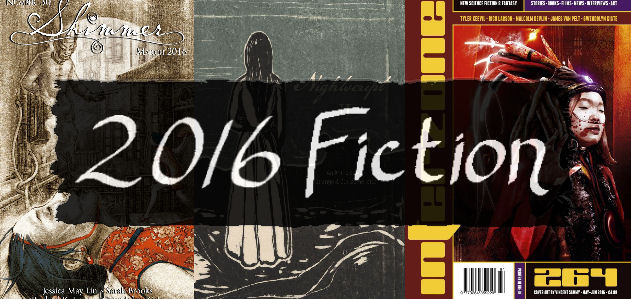 In 2016, I’m thrilled to say that I had fifteen works of original fiction published! That’s in addition to eleven reprints, which made for a busy year. It’s also super exciting that a number of those stories were my first appearances in fantastic publications including Shimmer, The Lift, Interzone, Daily Science Fiction, and Bracken, among others.
In 2016, I’m thrilled to say that I had fifteen works of original fiction published! That’s in addition to eleven reprints, which made for a busy year. It’s also super exciting that a number of those stories were my first appearances in fantastic publications including Shimmer, The Lift, Interzone, Daily Science Fiction, and Bracken, among others.